Haoqian Wang
Taming Hallucinations: Boosting MLLMs' Video Understanding via Counterfactual Video Generation
Dec 30, 2025Abstract:Multimodal Large Language Models (MLLMs) have made remarkable progress in video understanding. However, they suffer from a critical vulnerability: an over-reliance on language priors, which can lead to visual ungrounded hallucinations, especially when processing counterfactual videos that defy common sense. This limitation, stemming from the intrinsic data imbalance between text and video, is challenging to address due to the substantial cost of collecting and annotating counterfactual data. To address this, we introduce DualityForge, a novel counterfactual data synthesis framework that employs controllable, diffusion-based video editing to transform real-world videos into counterfactual scenarios. By embedding structured contextual information into the video editing and QA generation processes, the framework automatically produces high-quality QA pairs together with original-edited video pairs for contrastive training. Based on this, we build DualityVidQA, a large-scale video dataset designed to reduce MLLM hallucinations. In addition, to fully exploit the contrastive nature of our paired data, we propose Duality-Normalized Advantage Training (DNA-Train), a two-stage SFT-RL training regime where the RL phase applies pair-wise $\ell_1$ advantage normalization, thereby enabling a more stable and efficient policy optimization. Experiments on DualityVidQA-Test demonstrate that our method substantially reduces model hallucinations on counterfactual videos, yielding a relative improvement of 24.0% over the Qwen2.5-VL-7B baseline. Moreover, our approach achieves significant gains across both hallucination and general-purpose benchmarks, indicating strong generalization capability. We will open-source our dataset and code.
EchoMotion: Unified Human Video and Motion Generation via Dual-Modality Diffusion Transformer
Dec 21, 2025Abstract:Video generation models have advanced significantly, yet they still struggle to synthesize complex human movements due to the high degrees of freedom in human articulation. This limitation stems from the intrinsic constraints of pixel-only training objectives, which inherently bias models toward appearance fidelity at the expense of learning underlying kinematic principles. To address this, we introduce EchoMotion, a framework designed to model the joint distribution of appearance and human motion, thereby improving the quality of complex human action video generation. EchoMotion extends the DiT (Diffusion Transformer) framework with a dual-branch architecture that jointly processes tokens concatenated from different modalities. Furthermore, we propose MVS-RoPE (Motion-Video Syncronized RoPE), which offers unified 3D positional encoding for both video and motion tokens. By providing a synchronized coordinate system for the dual-modal latent sequence, MVS-RoPE establishes an inductive bias that fosters temporal alignment between the two modalities. We also propose a Motion-Video Two-Stage Training Strategy. This strategy enables the model to perform both the joint generation of complex human action videos and their corresponding motion sequences, as well as versatile cross-modal conditional generation tasks. To facilitate the training of a model with these capabilities, we construct HuMoVe, a large-scale dataset of approximately 80,000 high-quality, human-centric video-motion pairs. Our findings reveal that explicitly representing human motion is complementary to appearance, significantly boosting the coherence and plausibility of human-centric video generation.
Measuring and Controlling the Spectral Bias for Self-Supervised Image Denoising
Oct 01, 2025Abstract:Current self-supervised denoising methods for paired noisy images typically involve mapping one noisy image through the network to the other noisy image. However, after measuring the spectral bias of such methods using our proposed Image Pair Frequency-Band Similarity, it suffers from two practical limitations. Firstly, the high-frequency structural details in images are not preserved well enough. Secondly, during the process of fitting high frequencies, the network learns high-frequency noise from the mapped noisy images. To address these challenges, we introduce a Spectral Controlling network (SCNet) to optimize self-supervised denoising of paired noisy images. First, we propose a selection strategy to choose frequency band components for noisy images, to accelerate the convergence speed of training. Next, we present a parameter optimization method that restricts the learning ability of convolutional kernels to high-frequency noise using the Lipschitz constant, without changing the network structure. Finally, we introduce the Spectral Separation and low-rank Reconstruction module (SSR module), which separates noise and high-frequency details through frequency domain separation and low-rank space reconstruction, to retain the high-frequency structural details of images. Experiments performed on synthetic and real-world datasets verify the effectiveness of SCNet.
DreamSwapV: Mask-guided Subject Swapping for Any Customized Video Editing
Aug 20, 2025Abstract:With the rapid progress of video generation, demand for customized video editing is surging, where subject swapping constitutes a key component yet remains under-explored. Prevailing swapping approaches either specialize in narrow domains--such as human-body animation or hand-object interaction--or rely on some indirect editing paradigm or ambiguous text prompts that compromise final fidelity. In this paper, we propose DreamSwapV, a mask-guided, subject-agnostic, end-to-end framework that swaps any subject in any video for customization with a user-specified mask and reference image. To inject fine-grained guidance, we introduce multiple conditions and a dedicated condition fusion module that integrates them efficiently. In addition, an adaptive mask strategy is designed to accommodate subjects of varying scales and attributes, further improving interactions between the swapped subject and its surrounding context. Through our elaborate two-phase dataset construction and training scheme, our DreamSwapV outperforms existing methods, as validated by comprehensive experiments on VBench indicators and our first introduced DreamSwapV-Benchmark.
MeshCoder: LLM-Powered Structured Mesh Code Generation from Point Clouds
Aug 20, 2025Abstract:Reconstructing 3D objects into editable programs is pivotal for applications like reverse engineering and shape editing. However, existing methods often rely on limited domain-specific languages (DSLs) and small-scale datasets, restricting their ability to model complex geometries and structures. To address these challenges, we introduce MeshCoder, a novel framework that reconstructs complex 3D objects from point clouds into editable Blender Python scripts. We develop a comprehensive set of expressive Blender Python APIs capable of synthesizing intricate geometries. Leveraging these APIs, we construct a large-scale paired object-code dataset, where the code for each object is decomposed into distinct semantic parts. Subsequently, we train a multimodal large language model (LLM) that translates 3D point cloud into executable Blender Python scripts. Our approach not only achieves superior performance in shape-to-code reconstruction tasks but also facilitates intuitive geometric and topological editing through convenient code modifications. Furthermore, our code-based representation enhances the reasoning capabilities of LLMs in 3D shape understanding tasks. Together, these contributions establish MeshCoder as a powerful and flexible solution for programmatic 3D shape reconstruction and understanding.
Make Your MoVe: Make Your 3D Contents by Adapting Multi-View Diffusion Models to External Editing
Aug 11, 2025Abstract:As 3D generation techniques continue to flourish, the demand for generating personalized content is rapidly rising. Users increasingly seek to apply various editing methods to polish generated 3D content, aiming to enhance its color, style, and lighting without compromising the underlying geometry. However, most existing editing tools focus on the 2D domain, and directly feeding their results into 3D generation methods (like multi-view diffusion models) will introduce information loss, degrading the quality of the final 3D assets. In this paper, we propose a tuning-free, plug-and-play scheme that aligns edited assets with their original geometry in a single inference run. Central to our approach is a geometry preservation module that guides the edited multi-view generation with original input normal latents. Besides, an injection switcher is proposed to deliberately control the supervision extent of the original normals, ensuring the alignment between the edited color and normal views. Extensive experiments show that our method consistently improves both the multi-view consistency and mesh quality of edited 3D assets, across multiple combinations of multi-view diffusion models and editing methods.
DPoser-X: Diffusion Model as Robust 3D Whole-body Human Pose Prior
Aug 01, 2025Abstract:We present DPoser-X, a diffusion-based prior model for 3D whole-body human poses. Building a versatile and robust full-body human pose prior remains challenging due to the inherent complexity of articulated human poses and the scarcity of high-quality whole-body pose datasets. To address these limitations, we introduce a Diffusion model as body Pose prior (DPoser) and extend it to DPoser-X for expressive whole-body human pose modeling. Our approach unifies various pose-centric tasks as inverse problems, solving them through variational diffusion sampling. To enhance performance on downstream applications, we introduce a novel truncated timestep scheduling method specifically designed for pose data characteristics. We also propose a masked training mechanism that effectively combines whole-body and part-specific datasets, enabling our model to capture interdependencies between body parts while avoiding overfitting to specific actions. Extensive experiments demonstrate DPoser-X's robustness and versatility across multiple benchmarks for body, hand, face, and full-body pose modeling. Our model consistently outperforms state-of-the-art alternatives, establishing a new benchmark for whole-body human pose prior modeling.
NOVA3D: Normal Aligned Video Diffusion Model for Single Image to 3D Generation
Jun 09, 2025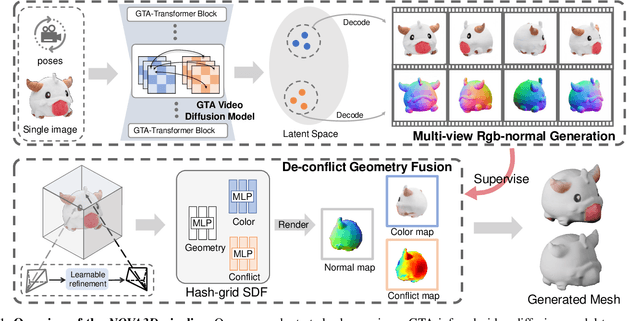
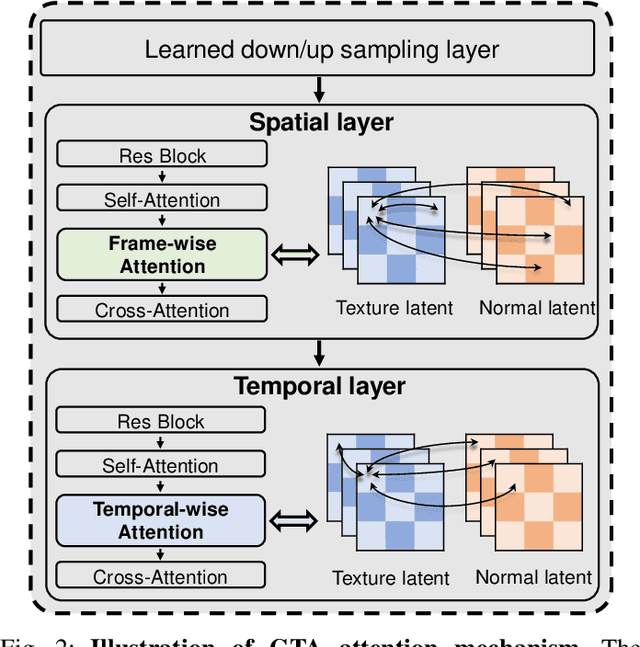
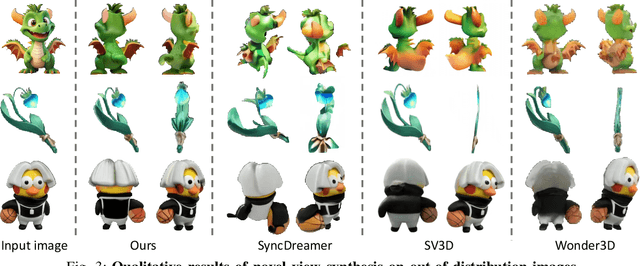

Abstract:3D AI-generated content (AIGC) has made it increasingly accessible for anyone to become a 3D content creator. While recent methods leverage Score Distillation Sampling to distill 3D objects from pretrained image diffusion models, they often suffer from inadequate 3D priors, leading to insufficient multi-view consistency. In this work, we introduce NOVA3D, an innovative single-image-to-3D generation framework. Our key insight lies in leveraging strong 3D priors from a pretrained video diffusion model and integrating geometric information during multi-view video fine-tuning. To facilitate information exchange between color and geometric domains, we propose the Geometry-Temporal Alignment (GTA) attention mechanism, thereby improving generalization and multi-view consistency. Moreover, we introduce the de-conflict geometry fusion algorithm, which improves texture fidelity by addressing multi-view inaccuracies and resolving discrepancies in pose alignment. Extensive experiments validate the superiority of NOVA3D over existing baselines.
High Quality Underwater Image Compression with Adaptive Correction and Codebook-based Augmentation
May 15, 2025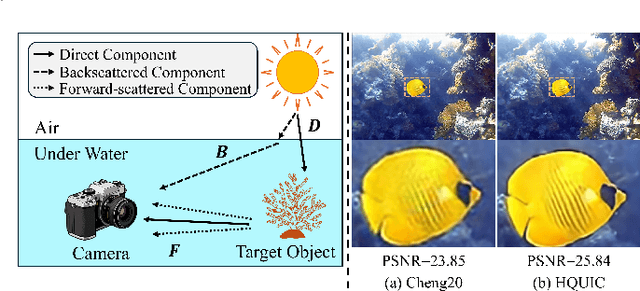
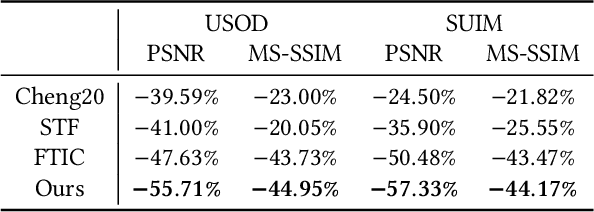
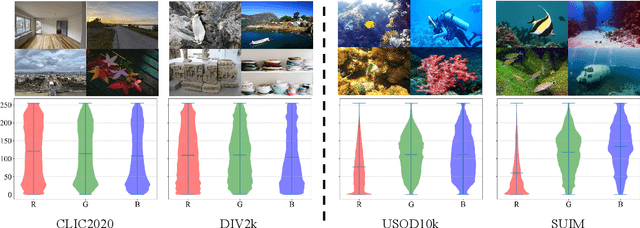
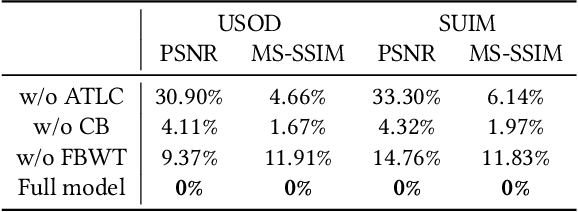
Abstract:With the increasing exploration and exploitation of the underwater world, underwater images have become a critical medium for human interaction with marine environments, driving extensive research into their efficient transmission and storage. However, contemporary underwater image compression algorithms fail to fully leverage the unique characteristics distinguishing underwater scenes from terrestrial images, resulting in suboptimal performance. To address this limitation, we introduce HQUIC, designed to exploit underwater-image-specific features for enhanced compression efficiency. HQUIC employs an ALTC module to adaptively predict the attenuation coefficients and global light information of the images, which effectively mitigates the issues caused by the differences in lighting and tone existing in underwater images. Subsequently, HQUIC employs a codebook as an auxiliary branch to extract the common objects within underwater images and enhances the performance of the main branch. Furthermore, HQUIC dynamically weights multi-scale frequency components, prioritizing information critical for distortion quality while discarding redundant details. Extensive evaluations on diverse underwater datasets demonstrate that HQUIC outperforms state-of-the-art compression methods.
Towards Facial Image Compression with Consistency Preserving Diffusion Prior
May 09, 2025Abstract:With the widespread application of facial image data across various domains, the efficient storage and transmission of facial images has garnered significant attention. However, the existing learned face image compression methods often produce unsatisfactory reconstructed image quality at low bit rates. Simply adapting diffusion-based compression methods to facial compression tasks results in reconstructed images that perform poorly in downstream applications due to insufficient preservation of high-frequency information. To further explore the diffusion prior in facial image compression, we propose Facial Image Compression with a Stable Diffusion Prior (FaSDiff), a method that preserves consistency through frequency enhancement. FaSDiff employs a high-frequency-sensitive compressor in an end-to-end framework to capture fine image details and produce robust visual prompts. Additionally, we introduce a hybrid low-frequency enhancement module that disentangles low-frequency facial semantics and stably modulates the diffusion prior alongside visual prompts. The proposed modules allow FaSDiff to leverage diffusion priors for superior human visual perception while minimizing performance loss in machine vision due to semantic inconsistency. Extensive experiments show that FaSDiff outperforms state-of-the-art methods in balancing human visual quality and machine vision accuracy. The code will be released after the paper is accepted.
 Add to Chrome
Add to Chrome Add to Firefox
Add to Firefox Add to Edge
Add to Edge